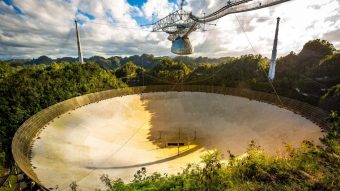Dec. 8, 2020
Contact: Austin Fitzgerald, 573-882-6217, fitzgeraldac@missouri.edu
On the morning of Dec. 1, the Arecibo radio telescope — a storied tool for atmospheric science and astronomy that has produced valuable research for decades — collapsed. Standing atop the Arecibo Observatory in Arecibo, Puerto Rico, the enormous telescope was the largest of its kind in the world until the Aperture Spherical Telescope was erected in China in 2016.
Anthony Lupo, a professor of atmospheric science at the University of Missouri’s College of Agriculture, Food and Natural Resources, offers his thoughts below about what the world’s scientific community has lost with Arecibo’s collapse. Lupo is also available to speak to media on this subject.
What made Arecibo special?
The Arecibo telescope’s enormous size allowed researchers to study the ionosphere, which is where the edge of the earth’s atmosphere meets solar wind from far beyond our planet. The gases in the ionosphere actually make it possible for us to communicate at great distances using radio waves. Being able to study that region of the atmosphere with the detail afforded by Arecibo has led to many advances in how we use radio waves. The facility also used “LIDAR,” a type of radar that can see clouds that are too high or thin for the naked eye. That’s very useful for studying atmospheric weather conditions.

Anthony Lupo, a professor of atmospheric science, won the SEC's 2020 Faculty Achievement Award earlier this year.
It’s sad to see what the sands of time have done to Arecibo, but it’s also important to remember that scientists have safety nets — Arecibo is not the lone marvel it was in 1963. We now have the Hubble Space Telescope and China’s Aperture Spherical Telescope, among others. Arecibo was, and continues to be, an irreplaceable facility worth preserving, both for its scientific capabilities and for its cultural impact. James Bond climbed the telescope in “GoldenEye,” and it was also featured in the Jodie Foster film, “Contact.” Luckily, with the resources available to scientists today, there shouldn’t be too much of a disruption to the type of research that Arecibo supported.
What can we learn from this collapse?
Arecibo is located in the tropics, so it is regularly exposed to tropical storm conditions. Just a few months ago, the facility weathered tropical storm Isaias. This doesn’t necessarily mean we shouldn’t put observatories in tropical locations, but it highlights the need for regular upkeep and upgrades. A cutting-edge facility needs cutting-edge funding. Unfortunately, that didn’t happen for Arecibo.
I have been involved in the review process for several research papers that relied on research performed at Arecibo. And like many people, I’ve been inspired by the grandeur of the telescope and the scope of the research it made possible. The Arecibo telescope was a reminder of what can be accomplished when brilliant engineers, researchers and financial support come together in the service of science. It’s rare that something like a telescope becomes a go-to Hollywood symbol, and it’s a shame that something so inspirational has been reduced to rubble.





